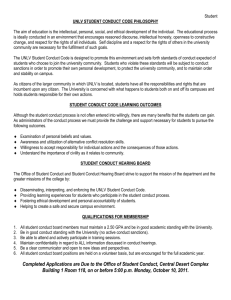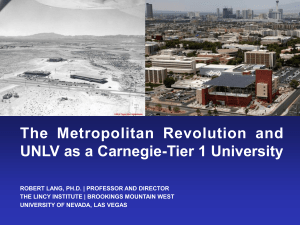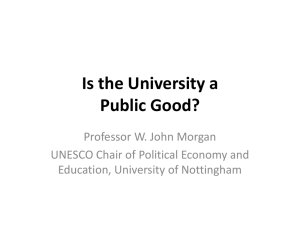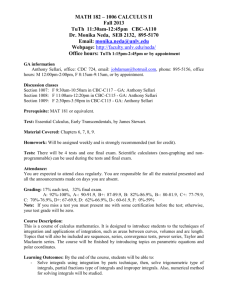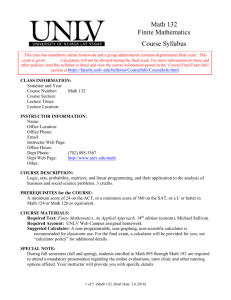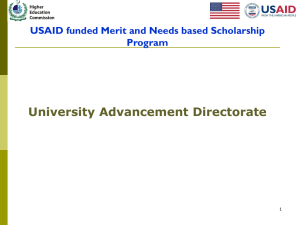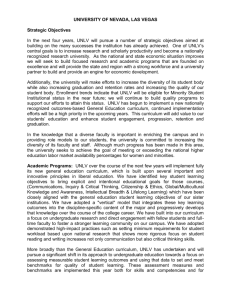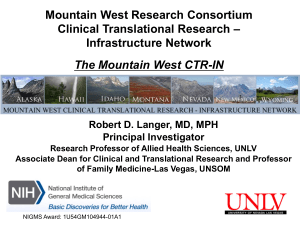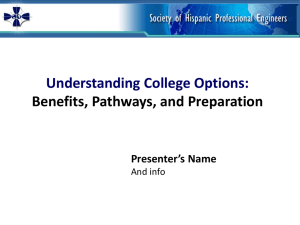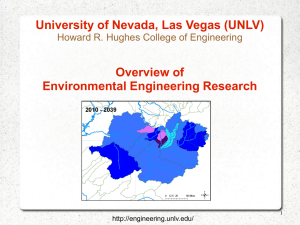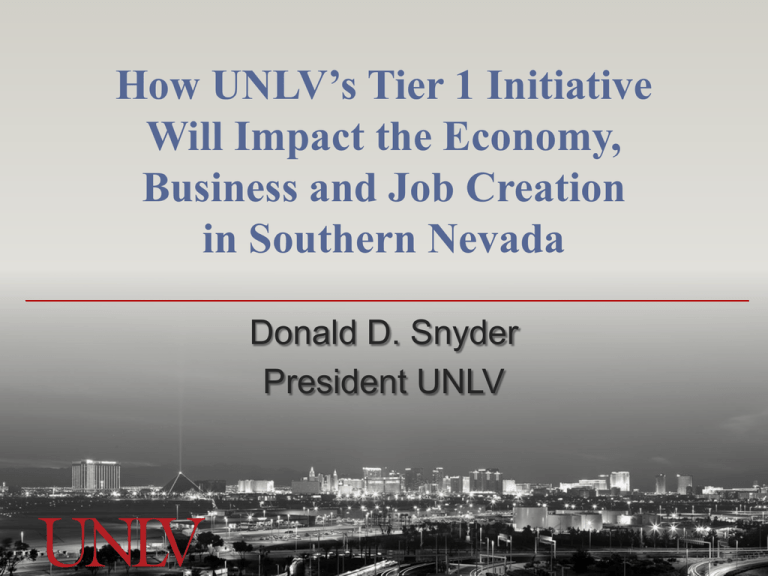
How UNLV’s Tier 1 Initiative
Will Impact the Economy,
Business and Job Creation
in Southern Nevada
Donald D. Snyder
President UNLV
Research Universities
linchpins of U. S. economy since 1950s
focus on granting college degrees
also focus on research, innovation
crucial to regional economic development
Western Research Universities (2012)
Research Universities in Nevada
SRI/ Brookings report:
“shortcomings of current
innovation system
…Nevada lags behind
other states and the
nation on every indicator
of innovation and
Research & Development
activity”
Research Universities in Nevada
SRI/ Brookings report:
“threats” to the Nevada
economy :
“underinvestment in
higher education”
“lack of a top-ranked
Carnegie research
university”
Research Universities in Nevada
SRI/ Brookings: Southern Nevada innovation capacity
“underdeveloped” despite “significant strengths”.
> 50% state’s advanced degrees from UNLV but
only 25% of academic R&D spending
UNLV < 25% of state-funded lab space
only ½ of so. NV lab space is bio-medical
Outcome: only 25% of National Science Foundation
funds to state come to Las Vegas.
Research Universities in Nevada
SRI/ Brookings
recommendation:
expand role of research
universities:
in Research &
Development through
industry collaborations
in Workforce
Development through
advanced degrees
UNLV
UNLV is where to
address this critical
regional economic
development need
UNLV as a Research University
Science Coalition report: Sparking Economic Growth 2.0
value of university research to
regional economic
development
university research is both basic
(technological innovation) and
applied (specific products,
services)
university research creates
technologies, not just products
more sustainable industries
higher levels of skills, pay for
technology workforce
technology firms more likely to
attract venture capital
Universities Drive Economic Growth
RESEARCH UNIVERSITIES AND THE FUTURE OF
AMERICA. REPORT BY THE NATIONAL RESEARCH
COUNCIL (2012)
“We believe that America’s research universities are today
a key asset for our nation’s future. …Our future now
depends on the willingness of our current policymakers to
follow their example and make the decisions that will allow
us to continue to compete, prosper, and shape our
destiny…. ”
Universities Drive Economic Growth
RESEARCH UNIVERSITIES AND THE FUTURE OF
AMERICA. REPORT BY THE NATIONAL RESEARCH
COUNCIL (2012)
“...other nations have recognized the importance of worldclass research universities and of university-driven
research and advanced education to economic prosperity
and social well-being. They are strategically and rapidly
strengthening their research universities to compete for
international students and faculty, resource, and reputation
and [they] have closely tied university research to
business.”
Universities Thrive in Major Cities
“It makes the most sense to put new top tier
institutions in large cities ….You need the
sophistication of a major city to be able to
take advantage of all the connections and
opportunities these institutions can bring.”
- Larry Faulkner, President Emeritus, UT Austin
UNLV and the Las Vegas community
“You cannot have a great community without
a great university …connected to that
community”
- Donald D. Snyder
UNLV goals for the community
Quality, value education
remain accessible, affordable for students
attract competitive students in-state, nationally
Fulfill recent NSHE, state mandates
completion: funding based on student performance
alignment: degrees in economic development areas
Serve regional needs
Minority Serving Institution designation
Research University / Very High designation
UNLV educational objectives (10-year)
Commitment to improving quality
60% undergraduate graduation rate
Reform of General Education
Improve basic Mathematics, Communications
Increased focus on Science, Technology, Engineering and
Mathematics degrees
Develop innovative programs such as IT, Gaming Law,
Urban Leadership, Graphic Design and Media, Aeronautic
Systems, etc.
4250 undergraduate degrees per year
25% of students in graduate, professional programs
1500 grad/ professional degrees per year
Carnegie Foundation
Research University designations
UNLV 2010 : “High Research” (top 4.5%)
20-Year goal is “Very High Research” (top 2.3 %)
108 Research Universities/ Very High as of 2010
75 are public universities
74 have medical schools
2 Minority-Serving Institutions currently designated as
Research University/ Very High
Carnegie Foundation
Research University designations
Key metrics
Doctoral degrees awarded
Across all fields of study
Research grant and contract expenditures
science and engineering
other fields
Research professionals (e.g. post-docs)
Faculty size
UNLV Tier 1 : 20-Year Business Plan
1.
2.
3.
4.
5.
6.
Analysis of Current Conditions
Phase 1: 10 Years to Build Capacity
Resources Need to Build Capacity
10-Year Targets
20-Year Performance Targets
Annual Benefits to Community Upon
Completion of Plan
1. Analysis of current conditions
Comparison with 4 universities: Oregon;
Colorado, Boulder; Utah; Arizona State
All Research Universities/ Very High
All public universities in Mountain West region
Not land grant institutions
3 of 4 do not have medical schools
3 of 4 in “Mountain Mega” cities
Key Findings : UNLV, c. 2011
Faculty Size
From peak of 925 down to 780
average size of Tier 1 university = 1200
Campus Size
400,000 GSF smaller than comparators
200,000 GSF lab space below comparators
Key Findings : UNLV, c. 2011
Grant/ Contract activity
< $30M per year (by NSF methodology)
> $80M per year below comparators
2. 10-Year Plan to Build Capacity
add 250 new full-time faculty lines
prioritize Economic Development areas
recruit research-active faculty
add 300 graduate scholarships
expand research support staff
upgrade, expand existing lab space
enhance internet connectivity and highperformance computing capacity
3. Resources Needed to Build Capacity
Restore cuts in state funding over 10 years
10-year investment to rebuild research capacity
performance benchmarks, careful oversight
Performance funds, student fees devoted to
student success (ensuring graduation)
State capital funds plus community support
for campus infrastructure
Federal, state, private grant/ contract
expansion for research support
4. 10-Year Targets
1200 full-time faculty members
increased average research productivity per
faculty member to $100,000 per year
350 research support staff
post-doctoral scholars, research scientists,
librarians, etc. (mostly self-supporting)
400,000 additional gross square feet
5. 20-Year Performance Targets
$120M in annual grant / contract
expenditures (from current $40M)
160 post-doctoral researchers supported
by external funding (currently 61)
200 doctorates per year (current 100)
30 graduate programs ranked in top 100
(current 11)
6. Benefits to Community in 20 Years
> 5000 quality degrees per year
annual economic impact of nearly $9b
direct expenditure
economic spin-off
value added of education to workforce
12 start-ups per year from UNLV research
2500 high-paying jobs (off campus) created
each year from spin-off of UNLV research

